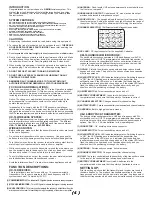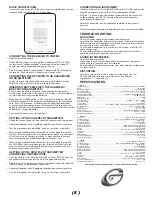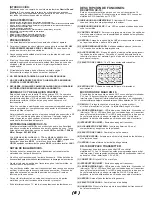
(5)
(5)
(5)
(5)
(5)
BASIC CONNECTIONS:
Connect the receiver output to the audio mixer or amplifier input, using a
standard audio cable with the 1/4”
phone plugs.
CONNECTING THE RECEIVER TO POWER:
•
Point the antennas upward.
•
Check that the voltage of the supplied AC adapter (AC110 or AC220)
conforms to the voltage available in local area. Using the wrong AC
adapter may cause irreparable damage to the unit.
•
Plug the feeder cable of the supplied AC adapter into DC IN socket on
the receiver. Then plug the AC adapter into a power outlet.
CONNECTING THE RECEIVER TO AN AUDIO MIXER
OR AN AMPLIFIER:
In order to make sure the sound quality and avoid distortion, please
adjust the volume level according to following instructions.
INSERTING BATTERIES INTO THE HANDHELD/
BODYPACK TRANSMITTER:
•
Push to open the battery cover and insert batteries into the battery
compartment conforming to the polarity (+)(-) marks. The transmitter can
not work with incorrectly inserted batteries.
•
When push the ON/OFF switch to “ON” to switch the power on, the LED
will flash momentarily. If the battery has sufficient power, the LED flashes
once. If the LED stayed on, it indicates that the battery has insufficient
power and should be changed soon. If the status LED fails to flash, the
battery is either dead or not positioned correctly, and you should correct the
positioning or change the battery.
•
Push back the battery cover to click it shut.
SETTING UP THE HANDHELD TRANSMITTER:
•
Switch the receiver power on and check the frequency and volume level.
•
Switch the transmitter and hi-fi appliance (amplifier, tape deck etc.) power on.
•
Test the microphone and adjust the levels on your mixer or amplifier.
•
When using a standard audio cable with 1/4” phone plugs to plug into
the MIC IN on the audio mixer or on the amplifier, please turn the Volume
Level Control on the receiver to around 1 o’clock position, the output
level for balanced and unbalanced output is about at 77mV.
•
When using a standard audio cable with 1/4” phone plugs to plug into
the LINE IN on the mixer, please turn the Volume Level Control on the
receiver to around MAX position, the output level for unbalanced and
balanced output is about at 770mV.
SETTING UP THE BODYPACK TRANSMITTER:
CONNECTING A MICROPHONE:
•
Open the battery cover. Push the MIC/LINE switch to “MIC” and use the
supplied screwdriver to adjust the GAIN at appropriate position.
•
Plug the mini XLR connector end of the microphone cable into the audio
input connector on the bodypack transmitter.
•
Switch the transmitter and hi-fi appliance (amplifier, tape deck etc.) power on.
•
Test the microphone and adjust the levels on your mixer or amplifier.
CONNECTING AN INSTRUMENT
•
Open the battery cover. Push the MIC/LINE switch to “LINE” and use the
supplied screwdriver to adjust the GAIN at appropriate position.
•
Plug the 1/4” phone plug of the optional guitar cable to the output jack
on the instrument and the 1/8” mini plug into audio input connector
on the bodypack transmitter.
•
Switch the transmitter and hi-fi appliance (amplifier, tape deck etc.)
power on.
•
Play the instrument for testing and adjust the levels on your mixer or amplifier.
TROUBLE-SHOOTING:
NO SOUND:
Check the power supply of the microphone and receiver.
Check that the transmitter and receiver are tuned to the same frequency.
Check whether the hi-fi appliance is switched on and the receiver output
is connected to mixer or amplifier input.
Check whether transmitter is too far away from receiver or SQUELCH
control set too high.
Check whether receiver is located too near metal object or there are
obstructions between transmitter and receiver.
SOUND INTERFERENCE:
Check the antenna location.
When using 2 or above microphone sets simultaneously, make sure
that the chosen frequencies are not interfered.
Check whether the interference comes from other wireless microphones,
TV, radio and etc.
DISTORTION:
Check the volume level of the receiver is set too high or too low.
Check whether the interference comes from other wireless
microphones, TV, radio and etc.
SPECIFICATIONS:
UX-16:
Frequency range................................................................USA: 790 – 806MHz/Europe: 863 – 865MHz
Case.........................................................................................................................................Mini case
Receiving System..........................................................................................................PLL synthesized
Receiving Mode.............................................................................16CH, Single Channel, Non-diversity
Frequency Stability...................................................................................................................+/- 0.05%
Receiving Sensitivity................................................................................At 8 dBuV over 80dB S/N ratio
Image & Spurious Rej......................................................................................................80 dB minimum
Selectivity.....................................................................................................................................> 50dB
Modulation Mode................................................................................................................................FM
IF Frequency................................................................................................1st: 56MHz 2nd: 10.7MHz
Dynamic Range.............................................................................................................................>96dB
Tone Signal...........................................................................................................................32.768KHz
S/N Response..............................................Over 94dB, at 48KHz deviation and 60dBuV antenna input
AF Response......................................................................................................50Hz to 15KHz(+/-3dB)
T.H.D. ...............................................................................................................................<1%(at 1KHz)
Power Supply.......................................................................................................................DC 12 ~ 18V
Audio Output...........................................................................................Balanced & unbalanced output
Current Consumption.....................................................................................................130mA +/- 10mA
Dimension(mm)WxHxD......................................................................................................130 x 36 x 92
XM-16:
Mic Type.....................................................................................................16CH, Handheld microphone
Frequency range................................................................USA: 790 – 806MHz/Europe: 863 – 865MHz
RF Power Output.................................................................................................................10mW(max.)
Oscillation Mode............................................................................................................PLL synthesized
Frequency Stability.................................................................................................................+/- 0.005%
Maximum Deviation............................................................................+/-48KHz with limiting compressor
Spurious Emission..................................................................................>60 dB below carrier frequency
T.H.D. ...............................................................................................................................<1%(at 1KHz)
Battery................................................................................................DC 3V(1.5v x 2 AA size batteries)
Tone Key................................................................................................................................32.768KHz
Mic Unit........................................................................................................Uni-directional dynamic unit
LED Indicator.........................................................................................Power ON-OFF and low battery
Current Consumption.............................................................................................................65 +/- 5mA
Dimension(mm)WxH..................................................................................................................272 x 62
XB-16
Mic Type......................................................................................................16CH, Bodypack transmitter
Frequency range...................................................................USA: 790-806MHz/Europe: 863 – 865MHz
RF Power Output.................................................................................................................10mW(max.)
Oscillation Mode............................................................................................................PLL synthesized
Frequency Stability.................................................................................................................+/- 0.005%
Maximum Deviation............................................................................+/-48KHz with limiting compressor
Spurious Emission..................................................................................>60 dB below carrier frequency
T.H.D. ...............................................................................................................................<1%(at 1KHz)
Battery................................................................................................DC 3V(1.5v x 2 AA size batteries)
Tone Key................................................................................................................................32.768KHz
Mic Unit....................................................................................................Uni-directional condenser unit
LED Indicator.........................................................................................Power ON-OFF and low battery
Current Consumption.............................................................................................................65 +/- 5mA
Dimension(mm)WxHxD........................................................................................................66 x 97 x 25
DESIGN AND SPECIFICATIONS SUBJECT TO CHANGE WITHOUT NOTICE.





























